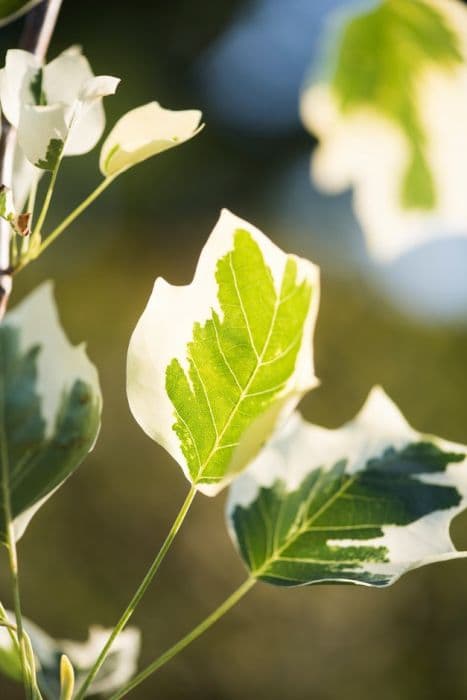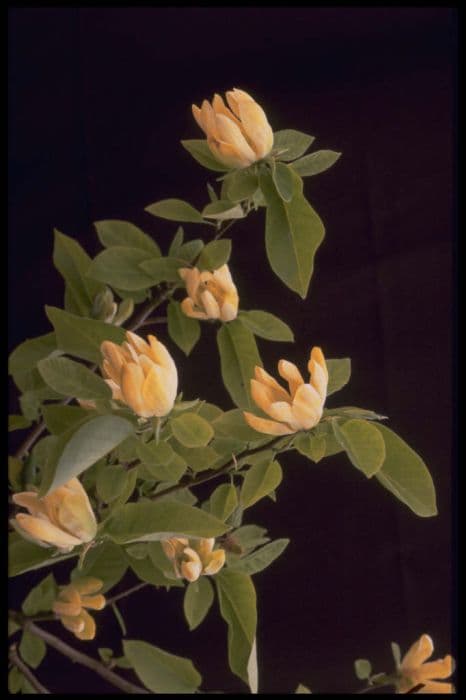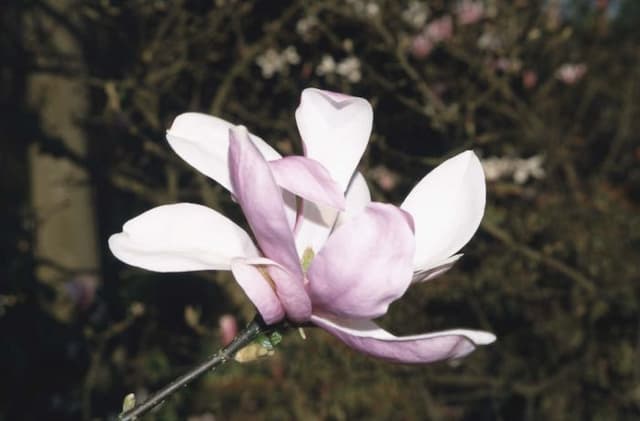Loebner Magnolia Magnolia × loebneri 'Leonard Messel'

ABOUT
The Magnolia × loebneri 'Leonard Messel' is an ornamental plant known for its stunning spring display. It's adorned with an abundance of flowers, each consisting of narrow petals that are a soft pink on the outside and fade to a lighter, almost white color towards the center. The petals have a strap-like shape, which adds to the overall texture and visual interest of the bloom. The flowers have a star-like appearance when fully open, emitting a delicate fragrance that attracts pollinators and hints at the arrival of spring. Nestled among the flowers, the plant's foliage emerges as bright green leaves, providing a beautiful contrast against the early blooms. Over time, these leaves will develop a lush canopy that remains an attractive deep green throughout the growing season. The leaves are smooth-edged and have an elongated oval shape, with a pointed tip creating an overall elegant silhouette. The Magnolia × loebneri 'Leonard Messel' holds its own as a specimen plant in the garden, enchanting onlookers with its pastel-hued floral display and its graceful, poised foliage.
About this plant
 Names
NamesFamily
Magnoliaceae
Synonyms
Leonard Messel Magnolia, Loebner Magnolia
Common names
Magnolia × loebneri 'Leonard Messel'
 Toxicity
ToxicityTo humans
TheLoebner magnolia (Magnolia × loebneri 'Leonard Messel') is not generally considered toxic to humans. There is no widespread evidence to suggest that this plant poses any significant risks upon ingestion. However, it is always possible for individuals to have specific allergies or reactions to any plant, and as such, consuming any plant not typically used for food should be approached with caution.
To pets
The Loebner magnolia (Magnolia × loebneri 'Leonard Messel') is also not generally considered toxic to pets. Similar to its effects on humans, there is no common evidence indicating that this plant is poisonous to pets. As such, if a pet ingests parts of this plant, significant toxicity is not expected. Nonetheless, ingestion of non-food plants can sometimes result in mild stomach upset in pets, so monitoring for any signs of gastrointestinal discomfort is advisable.
 Characteristics
CharacteristicsLife cycle
Perennials
Foliage type
Deciduous
Color of leaves
Green
Flower color
Pink
Height
10-15 feet (3-4.5 meters)
Spread
10-15 feet (3-4.5 meters)
Plant type
Tree
Hardiness zones
5
Native area
Hybrid
Benefits
 General Benefits
General Benefits- Aesthetic Appeal: Produces star-shaped pink flowers in early spring that add ornamental value to landscapes.
- Fragrance: The flowers emit a pleasant aroma that can enhance the sensory experience of a garden.
- Wildlife Attraction: Attracts beneficial pollinators such as bees and butterflies, contributing to the health of local ecosystems.
- Shade Provider: As a moderately sized tree, it can provide shade and cooling effects to gardens and yards.
- Year-Round Interest: Offers visual interest throughout the year with its flowers, summer foliage, and autumn fruit.
- Ease of Care: Known for being a low-maintenance plant that does not require extensive care once established.
- Adaptability: Can thrive in a variety of soil types and is relatively cold-hardy, increasing its suitability for different climates.
- Privacy Screen: Can be used as a screen or hedge to increase privacy and reduce noise in residential areas.
- Suitable for Small Spaces: Due to its compact growth habit, it is suitable for smaller gardens where space is limited.
 Medical Properties
Medical PropertiesThis plant is not used for medical purposes.
 Air-purifying Qualities
Air-purifying QualitiesThis plant is not specifically known for air purifying qualities.
 Other Uses
Other Uses- Photographic subject: The 'Leonard Messel' magnolia's stunning blooms make it a popular subject for photographers, especially when seeking to capture the essence of spring.
- Artistic inspiration: Artists may use the beautiful blooms and form of the magnolia as a motif in paintings, drawings, and other forms of visual art.
- Cultural symbols: In some cultures, magnolias are a symbol of purity and nobility, making the 'Leonard Messel' variety suitable for cultural and religious ceremonies.
- Wedding decor: With its delicate pink blossoms, the 'Leonard Messel' magnolia can be used in wedding bouquets, centerpieces, or as a natural decor element for spring weddings.
- Landscape design: The 'Leonard Messel' magnolia is often used in landscape architecture to create focal points or to enhance aesthetic appeal due to its showy flowers.
- Educational tool: This magnolia variety can be used in educational settings, such as botanical gardens, to help teach plant identification and horticultural practices.
- Culinary decoration: Although not edible, the flowers can be used as a non-toxic decorative element for plating high-end culinary dishes.
- Mood enhancer: The presence of a blooming 'Leonard Messel' magnolia in a garden setting can contribute to a sense of well-being and relaxation for onlookers.
- Fragrance extraction: While not a common use, the petals of magnolia can be used to create botanical extracts for perfumery or aromatherapy products.
- Biodiversity support: Planting 'Leonard Messel' magnolias can support local ecosystems by providing a food source and habitat for pollinators like bees and butterflies.
Interesting Facts
 Feng Shui
Feng ShuiThe Loebner Magnolia is not used in Feng Shui practice.
 Zodiac Sign Compitability
Zodiac Sign CompitabilityThe Loebner Magnolia is not used in astrology practice.
 Plant Symbolism
Plant Symbolism- Perseverance: The Magnolia × loebneri 'Leonard Messel', being a hybrid magnolia, is known for its hardiness and ability to withstand harsh conditions, symbolizing the strength to persevere through challenges.
- Nobility: Magnolias are often associated with nobility due to their graceful and impressive form, representing dignity and elegance.
- Femininity: The soft, often pink, petals of the flower are symbolic of feminine beauty and gentleness.
- Purity and Innocence: The white color of some 'Leonard Messel' magnolia flowers represents purity, cleanliness, and innocence in various cultural contexts.
 Water
WaterLeonard Messel Magnolia should be watered deeply and thoroughly, ensuring the root zone is moistened. During the first growing season, it's essential to maintain a consistent watering schedule to establish a deep and extensive root system. Water the plant once a week with approximately 1.5 to 2 gallons of water, adjusting for rainfall, soil type, and weather conditions. In subsequent years, the plant may require less frequent watering, but it is still important to water during dry spells. During the hot summer months, additional watering may be necessary.
 Light
LightLeonard Messel Magnolia thrives best in full sun to partial shade. An ideal spot is where the plant receives at least four to six hours of direct sunlight per day, but is sheltered from the intense midday sun. Locations that offer morning sunlight and afternoon shade are often ideal for this magnolia variety.
 Temperature
TemperatureLeonard Messel Magnolia is tolerant of a wide range of temperatures and can withstand winter cold to about -20 degrees Fahrenheit. The ideal temperature for this magnolia variety is between 60 and 75 degrees Fahrenheit. However, it can survive summer temperatures reaching up to 90 degrees Fahrenheit.
 Pruning
PruningPruning the Leonard Messel Magnolia is primarily done to remove dead or broken branches and to maintain its shape. The best time for pruning is after the plant has finished blooming in late spring. Cut back any unwanted branches and thin out dense areas to allow light and air to reach the inner sections. Pruning should be done sparingly as the plant may not need it every year.
 Cleaning
CleaningAs needed
 Soil
SoilThe best soil mix for Leonard Messel magnolia should be rich, well-draining, and slightly acidic to neutral in pH (5.5 to 7.0). A blend of loam, compost, and perlite or pine bark can provide the necessary structure and nutrients.
 Repotting
RepottingLeonard Messel magnolia, being a larger shrub or small tree, is typically not repotted. It is planted in the ground where it can grow without the need for repotting.
 Humidity & Misting
Humidity & MistingLeonard Messel magnolia prefers average to high humidity levels but is quite adaptable and can thrive in the typical outdoor humidity conditions found in its growing regions.
 Suitable locations
Suitable locationsIndoor
Provide bright light and ample space.
Outdoor
Plant in well-drained soil; full sun to part shade.
Hardiness zone
5-9 USDA
 Life cycle
Life cycleMagnolia × loebneri 'Leonard Messel', commonly known as Leonard Messel Magnolia, starts its life cycle as a seed, which, under suitable conditions, germinates in soil to establish a root system and sprout a shoot. The seedling stage is marked by the growth of the initial leaves and shoot system, developing into a young sapling. As the sapling matures, it undergoes a vegetative growth phase, where it increases in size and builds a more extensive root network, eventually reaching maturity. In spring, the mature Leonard Messel Magnolia enters its reproductive phase, characterized by the blooming of fragrant, star-shaped flowers, usually pink or lavender with white interiors, which attract pollinators. Following pollination, the plant produces seed-containing fruit, which upon dispersal, can lead to the establishment of new plants. Finally, in its declining years, the Magnolia may experience reduced vigor and flowering as it approaches senescence, completing its life cycle.
 Propogation
PropogationPropogation time
Early Spring
Magnolia × loebneri 'Leonard Messel', commonly known as Leonard Messel magnolia, is most effectively propagated through softwood cuttings. This technique involves taking a cutting of new growth that has not yet hardened, typically in late spring to early summer, when the plant is actively growing. The cutting, usually measuring 4-6 inches (10-15 cm), should include at least two sets of leaves. The bottom set of leaves is removed, and any large remaining leaves are cut in half to reduce moisture loss. The base of the cutting is then dipped in rooting hormone to encourage root development and inserted into a pot filled with a well-draining soil mixture. The environment should be kept humid, often by covering the pot with a plastic bag or placing it in a humid propagator, and maintaining a consistent temperature between 70-75°F (21-24°C). Rooting can take several weeks, and once established, the cutting can be gradually acclimatized to outdoor conditions before transplanting.



![Magnolia [Fairy Blush]](/_next/image?url=https%3A%2F%2Fplants-admin.emdemapps.com%2Fimages%2Fplants%2F%2Fimages%2F604b5a108e959.png&w=640&q=75)





